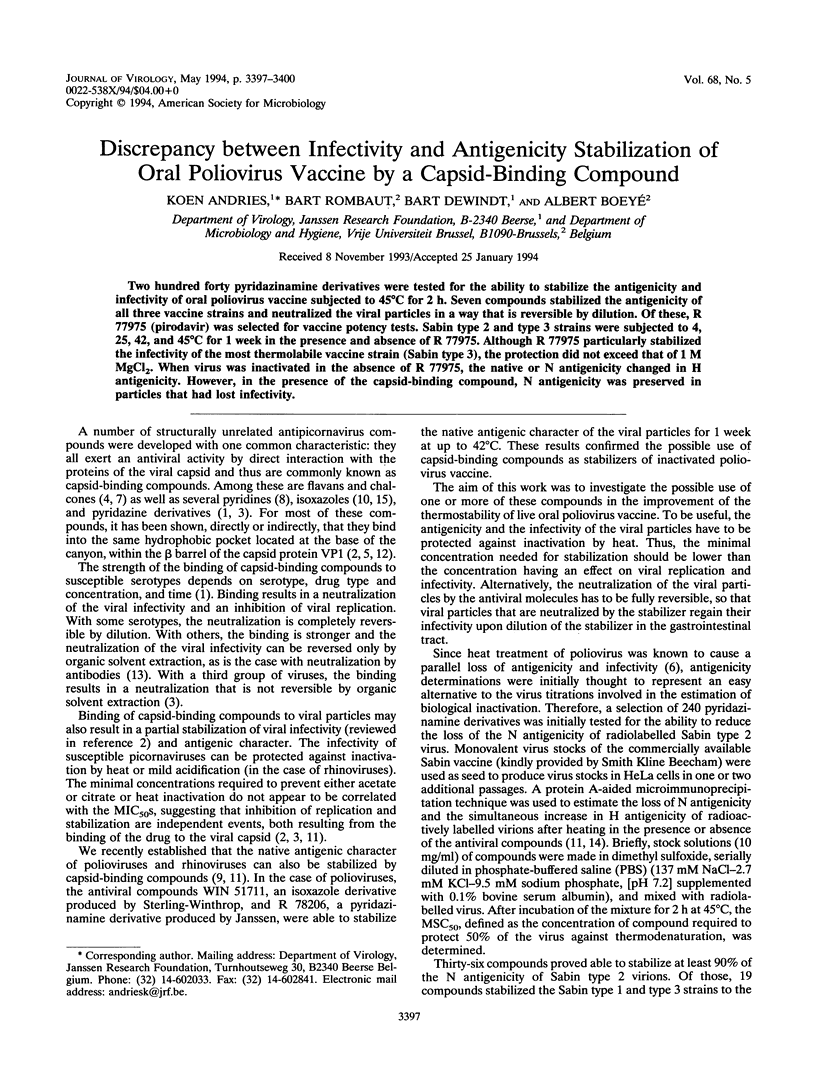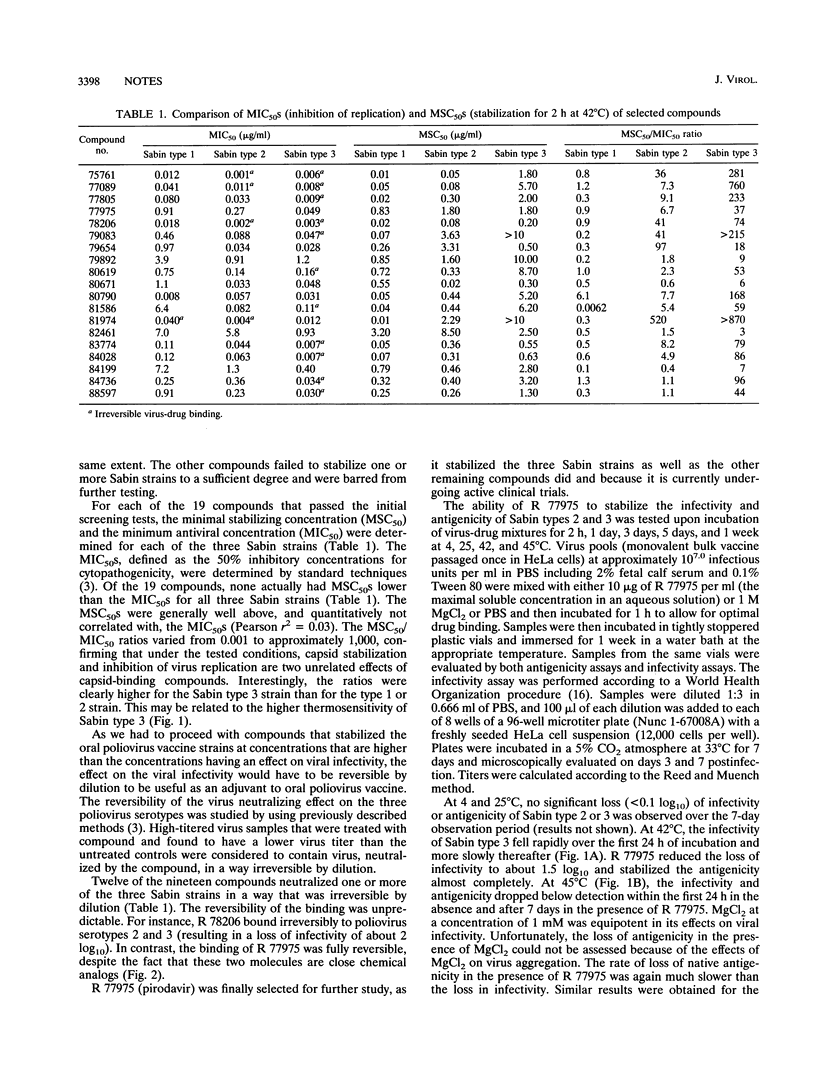Abstract
Two hundred forty pyridazinamine derivatives were tested for the ability to stabilize the antigenicity and infectivity of oral poliovirus vaccine subjected to 45 degrees C for 2 h. Seven compounds stabilized the antigenicity of all three vaccine strains and neutralized the viral particles in a way that is reversible by dilution. Of these, R 77975 (pirodavir) was selected for vaccine potency tests. Sabin type 2 and type 3 strains were subjected to 4, 25, 42, and 45 degrees C for 1 week in the presence and absence of R 77975. Although R 77975 particularly stabilized the infectivity of the most thermolabile vaccine strain (Sabin type 3), the protection did not exceed that of 1 M MgCl2. When virus was inactivated in the absence of R 77975, the native or N antigenicity changed in H antigenicity. However, in the presence of the capsid-binding compound, N antigenicity was preserved in particles that had lost infectivity.
Full text
PDF



Selected References
These references are in PubMed. This may not be the complete list of references from this article.
- Andries K., Dewindt B., De Brabander M., Stokbroekx R., Janssen P. A. In vitro activity of R 61837, a new antirhinovirus compound. Arch Virol. 1988;101(3-4):155–167. doi: 10.1007/BF01310997. [DOI] [PMC free article] [PubMed] [Google Scholar]
- Andries K., Dewindt B., Snoeks J., Willebrords R. Lack of quantitative correlation between inhibition of replication of rhinoviruses by an antiviral drug and their stabilization. Arch Virol. 1989;106(1-2):51–61. doi: 10.1007/BF01311037. [DOI] [PubMed] [Google Scholar]
- Andries K., Dewindt B., Snoeks J., Willebrords R., van Eemeren K., Stokbroekx R., Janssen P. A. In vitro activity of pirodavir (R 77975), a substituted phenoxy-pyridazinamine with broad-spectrum antipicornaviral activity. Antimicrob Agents Chemother. 1992 Jan;36(1):100–107. doi: 10.1128/aac.36.1.100. [DOI] [PMC free article] [PubMed] [Google Scholar]
- Bauer D. J., Selway J. W., Batchelor J. F., Tisdale M., Caldwell I. C., Young D. A. 4',6-Dichloroflavan (BW683C), a new anti-rhinovirus compound. Nature. 1981 Jul 23;292(5821):369–370. doi: 10.1038/292369a0. [DOI] [PMC free article] [PubMed] [Google Scholar]
- Chapman M. S., Minor I., Rossmann M. G., Diana G. D., Andries K. Human rhinovirus 14 complexed with antiviral compound R 61837. J Mol Biol. 1991 Feb 5;217(3):455–463. doi: 10.1016/0022-2836(91)90749-v. [DOI] [PubMed] [Google Scholar]
- Hinuma Y., Katagiri S., Fukuda M., Fukushi K., Watanabe Y. Kinetic studies on the thermal degradation of purified poliovirus. Biken J. 1965 Sep;8(3):143–153. [PubMed] [Google Scholar]
- Ishitsuka H., Ninomiya Y. T., Ohsawa C., Fujiu M., Suhara Y. Direct and specific inactivation of rhinovirus by chalcone Ro 09-0410. Antimicrob Agents Chemother. 1982 Oct;22(4):617–621. doi: 10.1128/aac.22.4.617. [DOI] [PMC free article] [PubMed] [Google Scholar]
- Kenny M. T., Dulworth J. K., Bargar T. M., Torney H. L., Graham M. C., Manelli A. M. In vitro antiviral activity of the 6-substituted 2-(3',4'-dichlorophenoxy)-2H-pyrano[2,3-b]pyridines MDL 20,610, MDL 20,646, and MDL 20,957. Antimicrob Agents Chemother. 1986 Sep;30(3):516–518. doi: 10.1128/aac.30.3.516. [DOI] [PMC free article] [PubMed] [Google Scholar]
- Moeremans M., De Raeymaeker M., Daneels G., De Brabander M., Aerts F., Janssen C., Andries K. Study of the parameters of binding of R 61837 to human rhinovirus 9 and immunobiochemical evidence of capsid-stabilizing activity of the compound. Antimicrob Agents Chemother. 1992 Feb;36(2):417–424. doi: 10.1128/aac.36.2.417. [DOI] [PMC free article] [PubMed] [Google Scholar]
- Otto M. J., Fox M. P., Fancher M. J., Kuhrt M. F., Diana G. D., McKinlay M. A. In vitro activity of WIN 51711, a new broad-spectrum antipicornavirus drug. Antimicrob Agents Chemother. 1985 Jun;27(6):883–886. doi: 10.1128/aac.27.6.883. [DOI] [PMC free article] [PubMed] [Google Scholar]
- Rombaut B., Andries K., Boeyé A. A comparison of WIN 51711 and R 78206 as stabilizers of poliovirus virions and procapsids. J Gen Virol. 1991 Sep;72(Pt 9):2153–2157. doi: 10.1099/0022-1317-72-9-2153. [DOI] [PubMed] [Google Scholar]
- SVEHAG S. E. REACTIVATION OF NEUTRALIZED VIRUS BY FLUOROCARBON: MECHANISM OF ACTION AND DEMONSTRATION OF REDUCED REACTIVABILITY WITH TIME OF VIRUS-ANTIBODY INTERACTION. Virology. 1963 Oct;21:174–182. doi: 10.1016/0042-6822(63)90254-x. [DOI] [PubMed] [Google Scholar]
- Smith T. J., Kremer M. J., Luo M., Vriend G., Arnold E., Kamer G., Rossmann M. G., McKinlay M. A., Diana G. D., Otto M. J. The site of attachment in human rhinovirus 14 for antiviral agents that inhibit uncoating. Science. 1986 Sep 19;233(4770):1286–1293. doi: 10.1126/science.3018924. [DOI] [PubMed] [Google Scholar]
- Vrijsen R., Rombaut B., Boeyé A. A simple quantitative protein A micro-immunoprecipitation method; assay of antibodies to the N and H antigens of poliovirus. J Immunol Methods. 1983 Apr 29;59(2):217–220. doi: 10.1016/0022-1759(83)90033-9. [DOI] [PubMed] [Google Scholar]
- Woods M. G., Diana G. D., Rogge M. C., Otto M. J., Dutko F. J., McKinlay M. A. In vitro and in vivo activities of WIN 54954, a new broad-spectrum antipicornavirus drug. Antimicrob Agents Chemother. 1989 Dec;33(12):2069–2074. doi: 10.1128/aac.33.12.2069. [DOI] [PMC free article] [PubMed] [Google Scholar]


